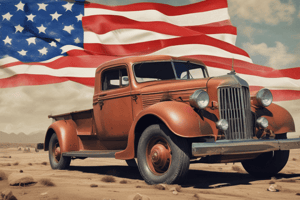Podcast
Questions and Answers
Cual foi o día no que se produciu a venda masiva de accións na bolsa de Nova York?
Cual foi o día no que se produciu a venda masiva de accións na bolsa de Nova York?
- 28 de outubro de 1929
- 24 de outubro de 1929 (correct)
- 26 de outubro de 1929
- 22 de outubro de 1929
Cal foi o nome da conferencia internacional celebrada en 1933 para buscar solucións á crise económica?
Cal foi o nome da conferencia internacional celebrada en 1933 para buscar solucións á crise económica?
- Conferencia de Londres (correct)
- Conferencia de Washington
- Conferencia de Nova York
- Conferencia de París
Que foi o nome do paquete de medidas políticas impulsadas por Roosevelt en 1933 para saír da crise?
Que foi o nome do paquete de medidas políticas impulsadas por Roosevelt en 1933 para saír da crise?
- O Novo Trato (correct)
- O Novo Acordo
- O Novo Pacto
- O Novo Camiño
Como se chamou a política de intervención do Estado na economía impulsada por Roosevelt en 1933?
Como se chamou a política de intervención do Estado na economía impulsada por Roosevelt en 1933?
Cal foi o nome do sistema político que se estableceu en varios países europeos a partir de 1930?
Cal foi o nome do sistema político que se estableceu en varios países europeos a partir de 1930?
Cal foi o nome do partido que seguía o modelo de Moscova?
Cal foi o nome do partido que seguía o modelo de Moscova?
Que foi o resultado das eleccións de 1920-1921 para o Partido Nacional Fascista?
Que foi o resultado das eleccións de 1920-1921 para o Partido Nacional Fascista?
Cual foi o obxectivo principal da política exterior de Mussolini?
Cual foi o obxectivo principal da política exterior de Mussolini?
Que foi o nome do partido de Hitler?
Que foi o nome do partido de Hitler?
Cual foi o resultado do Putsch de Múnic de 1923?
Cual foi o resultado do Putsch de Múnic de 1923?
Que foi o nome do movemento comunista liderado por Rosa Luxemburgo?
Que foi o nome do movemento comunista liderado por Rosa Luxemburgo?
Cual foi o nome do xefe de Estado alemán que apoiou a Hitler?
Cual foi o nome do xefe de Estado alemán que apoiou a Hitler?
Flashcards are hidden until you start studying
Study Notes
The Wall Street Crash of 1929
- The crisis began on October 24, 1929, known as Black Thursday, with a massive sale of shares on the New York Stock Exchange.
- Share prices plummeted, leading to a loss of value and a subsequent crash.
- The crisis, known as the Great Depression, led to a global economic downturn.
The Great Depression
- The crisis led to the collapse of banks, as loans were not repaid.
- There was a decrease in demand, leading to the closure of businesses.
- Farmers were ruined, and unemployment rates skyrocketed.
- The crisis spread globally, with the US reducing its imports and the US banking system withdrawing its capital from Europe.
The New Deal (1933)
- Introduced by President Roosevelt, it aimed to stabilize the economy.
- The New Deal included public works, subsidies for farmers, and improved labor conditions.
- It also led to the restructuring of the financial system.
The Rise of Totalitarianisms
- The crisis created a fragile democratic context, with social tensions and fear of a communist revolution.
- The collapse of authoritarian empires led to the rise of totalitarian regimes.
- Parties with extreme ideologies, such as fascist and communist parties, emerged.
- Dictatorships were established in Austria, Greece, and Spain, with a single party controlling the state and suppressing individual freedoms.
Fascist Italy
- After World War I, Italy experienced a strong sense of disappointment and frustration.
- The country faced inflation, unemployment, and social unrest.
- The Fascist Party, led by Benito Mussolini, gained popularity and eventually took power.
- The party's ideology was based on opposition to democracy and communism, with a strong leader and a cult of violence.
Mussolini's Rise to Power
- In 1921, Mussolini founded the National Fascist Party.
- The party used violence to control social disorder and eventually took power by force.
- Mussolini became the leader of the government and eventually established a dictatorship.
- He implemented a series of measures, including the suppression of individual freedoms, the elimination of opponents, and the implementation of a centralized economy.
Nazi Germany
- The Weimar Republic was established in 1919 after Germany's defeat in World War I.
- The republic was weak and faced opposition from both the extreme left and right.
- Hitler joined the German Workers' Party (DAP) in 1919 and eventually transformed it into the National Socialist German Workers' Party (NSDAP).
- Hitler's ideology was based on racism, anti-Semitism, and the concept of "lebensraum" (living space).
Hitler's Rise to Power
- Hitler's party gained popularity during a period of economic crisis and social unrest.
- The party's propaganda and cult of violence appealed to the German people.
- In 1932, Hitler became the Chancellor of Germany, and eventually, he established a dictatorship.
- The Nazi regime was characterized by its suppression of individual freedoms, its cult of violence, and its aggressive foreign policy.
Studying That Suits You
Use AI to generate personalized quizzes and flashcards to suit your learning preferences.




